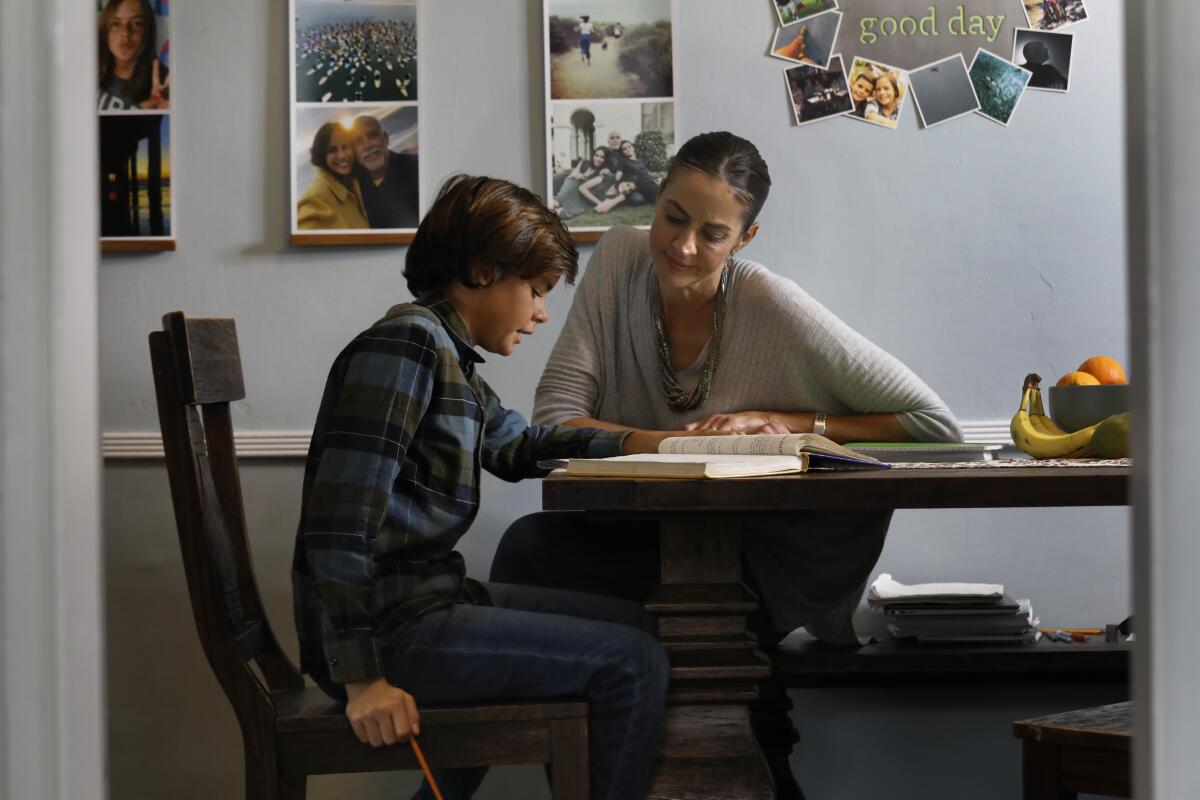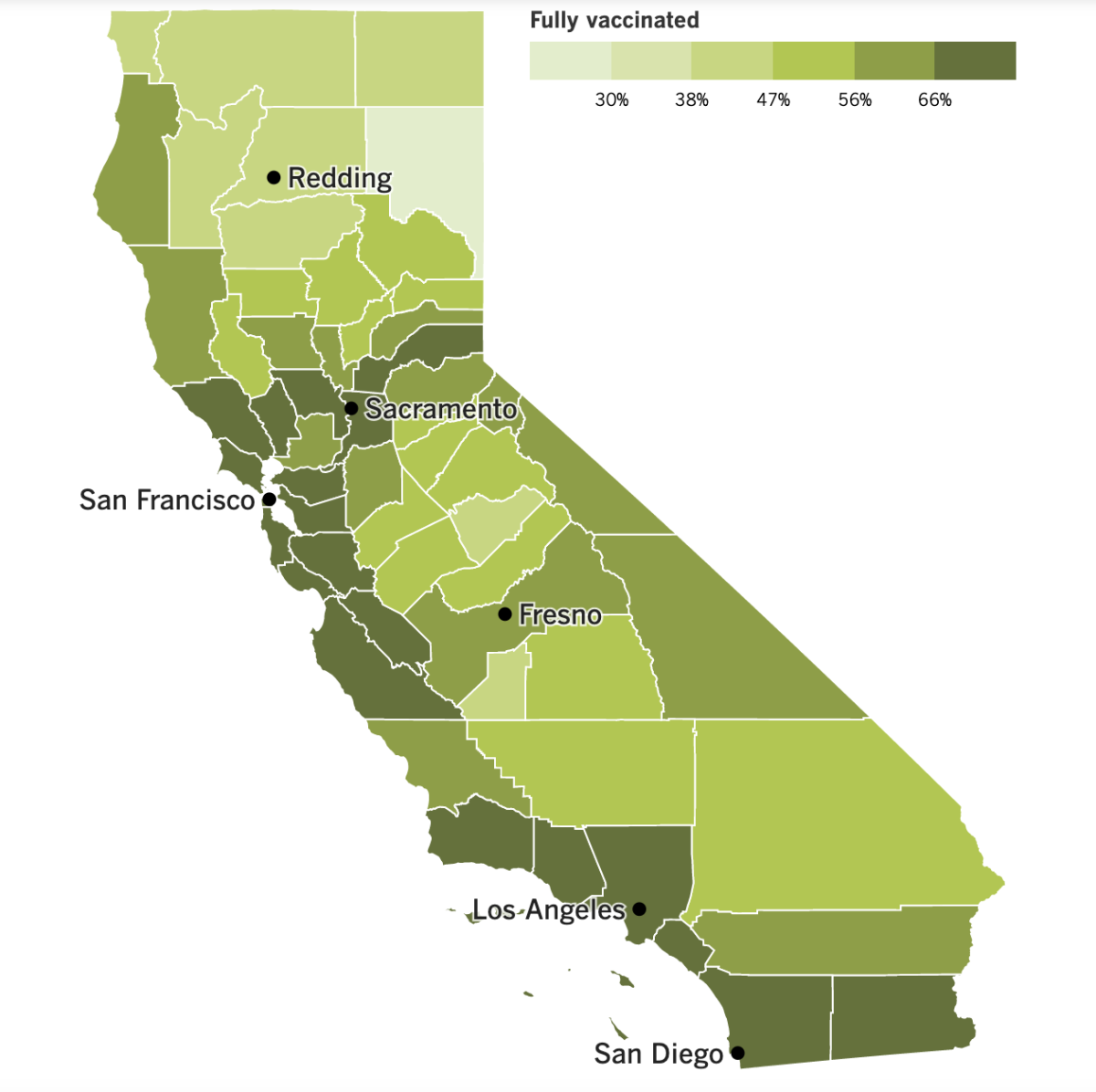Coronavirus Today: This had better not be the ‘new normal’
- Share via
Good evening. I’m Karen Kaplan, and it’s Friday, Jan. 21. Here’s the latest on what’s happening with the coronavirus in California and beyond.
With every passing day, more of us are ready to stop fighting the coronavirus and learn to coexist with it instead. The health ministry of Spain is preparing to make this the official policy for the country of 47 million people, and other European nations have taken steps in that direction as well.
The World Health Organization says it’s still too soon to treat COVID-19 as if it were the flu. So does Dr. Anthony Fauci, the U.S. government’s leading expert on infectious diseases. We can’t ease up until the disease drops to “a level that doesn’t disrupt society,” he said this week during an online panel hosted by the World Economic Forum.
Maybe you don’t trust these institutional experts. Or maybe you just can’t stand to listen to them anymore.
If you’re in the market for a different perspective, try Natalia Molina’s. Her 88-year-old mother caught COVID-19 a few weeks ago, and Molina is here to tell you it is definitely something you want to avoid.
Molina’s mother did as much as she could to protect herself. She was fully vaccinated and boosted. She wore a face mask diligently and was equipped with an N95 respirator. But it wasn’t enough.
Her illness has not been like a bad cold, or even a case of the flu. She had a hacking cough that kept her awake day and night. Her heart rate dropped to 50. Her blood pressure plunged 40 points in a single day.
What’s more, she didn’t have her daughter tending to her; the closest Molina could get was a camping chair set up outside her mom’s Echo Park apartment. She couldn’t get an appointment for her mother to see her doctor, even though she has medical insurance through Kaiser Permanente. She couldn’t get help in an emergency room, either; it was so overwhelmed with patients that it took eight hours for a nurse to call back to say she should sit tight at home.
There’s an antibody treatment that reduces the risk of becoming severely ill, but it only works if it’s taken right away. Molina’s mother missed her chance. It took three days for her daughter to line up a telemedicine appointment.
“This, it seems, is what ‘learning to live with COVID’ looks like,” writes Molina, a professor of American studies and ethnicity at USC.

She has another list of grievances about how unnecessarily difficult it is to schedule a vaccine appointment, get a coronavirus test, or find reliable information on topics such as how long to stay home from work after an infection. All of those things pretty much require a smartphone or a computer with an internet connection, and most of her elderly relatives lack both.
This is not how things usually go down when someone gets a bad cold or the flu. It’s not the old normal, and in Molina’s view, it had better not become the “new normal,” either.
“I don’t think enough people realize what the ‘new normal’ is,” she writes. “It doesn’t just mean wearing a mask when you go out or maybe getting a touch of flu. It means you’ll be providing healthcare at home as the actual healthcare system breaks.”
By the numbers
California cases and deaths as of 5:18 p.m. Friday:

Track California’s coronavirus spread and vaccination efforts — including the latest numbers and how they break down — with our graphics.
‘Words I never thought would cross my lips’
In the early days of the pandemic, when schools closed their doors and kitchen tables became classrooms, parents got their first close-up view of what their children were learning and how they were learning it. Many of them were not impressed. In some cases, that feeling stuck with them even after classrooms reopened.
Thousands of California parents are trying to remedy the situation by pulling their kids out of traditional schools and give home-schooling a try.
“To say I’m home-schooling my kid are words I never ever thought would cross my lips,” said Karen Mozian, a wellness business owner who cut back her hours so she could take charge of her sixth-grade son’s education.
Nearly 35,000 California families filed with the state to operate home schools during the 2020-2021 school year, my colleague Laura Newberry reports. That was more than double the number from the 2018-2019 school year, the last one of the pre-pandemic era.
Nationwide, 11.1% of families were home-schooling at least one child when the current school year began, up from 5.4% in the spring of 2020, according to the U.S. Census Bureau.
Some of those families chose this course for ideological reasons, as has historically been the case. But increasingly, they’re being joined by parents who are “mainstream middle class, well-educated and not on ether political extreme,” said James Dwyer, a law professor and co-author of “Homeschooling: The History and Philosophy of a Controversial Practice.” For them, he said, the choice is “more about competence” and being “very disenchanted with public schools’ response to the pandemic.”

Those were big factors for Mozian. When her son Elijah’s school went online, he barely engaged with his Zoom lessons and daydreamed during class. Once he was back on campus, he wasn’t comfortable advocating for the accommodations the school granted him to cope with his ADHD. On top of all that, COVID-19 restrictions added to his stress.
With her son’s grades falling, Mozian decided to try teaching him herself.
Some parents are pulling their kids out of traditional schools because they don’t see enough COVID-19 safety protocols. Some don’t want their children exposed to critical race theory; others don’t want their children in an environment where they’ll be pre-judged because of their race or ethnicity.
“They saw how teachers were talking to the children, the tone of their voice,” said Khadijah Z. Ali-Coleman, co-editor of the book “Homeschooling Black Children in the U.S.”
Gov. Gavin Newsom gave home-schooling another boost in October when he announced that the COVID-19 vaccine would be added to the list of mandatory vaccinations for the state’s public and private school students.
That rule won’t go into effect until the start of the next school year at the earliest, but Mozian said it’s likely to make her stick with home-schooling. Neither she nor her kids have gotten the shots because she’s concerned about their potential long-term effects.
Though the reasons for home-schooling vary widely, there’s one thing that unites the parents going down this road: a desire to take control of their children’s education when so much else remains uncertain.
California’s vaccination progress


See the latest on California’s vaccination progress with our tracker.
Your support helps us deliver the news that matters most.
In other news ...
The end of the Omicron surge may be in sight.
Around California, there are growing indications that the wave of cases spawned by the highly contagious variant is flattening. In some parts of the state, it’s even starting to wane.
Los Angeles County health officials are cautiously optimistic that the exponential growth of new cases may be behind them. Their counterparts in San Francisco say they’re now past the peak — the city is averaging about 2,000 cases per day, down from nearly 2,700 in early January.
In both Southern California and the San Francisco Bay Area, each person with a coronavirus infection is spreading it to fewer than one other person, on average, according to the state’s COVID Assessment Tool. In the San Joaquin Valley and Greater Sacramento regions, each infected person is infecting one more person, on average. Rural Northern California is the only area where the outbreak is still growing.
Nationwide, the average daily case count decreased 5% this week compared with last week, according to Dr. Rochelle Walensky, director of the Centers for Disease Control and Prevention.
The Omicron improvement is evident in L.A. Unified schools. The district said coronavirus rates fell and attendance rose this week compared with the previous week, though they’re still near record highs.
When students were tested in early January, about 170 out of every 1,000 had a coronavirus infection. After school resumed on Jan. 11, that ratio fell to 100 out of every 1,000. (In the week that ended Dec. 17, the last day of school before the break, only 2 out of 1,000 students tested positive.)
L.A. County health officials continue to advise against nonessential gatherings, especially things like dinners and parties that bring maskless people together in close proximity. The county is still averaging more than 34,000 newly reported cases per day, according to The Times’ tracker.
“We need to be extraordinarily cautious when there’s this much community transmission,” said Public Health Director Barbara Ferrer. “We’ve actually never had this much community transmission at any other point during the pandemic.”
The county had 102 COVID-19 deaths on Thursday, the highest single-day total since March 10, 2021. The number of deaths per week has doubled in L.A. County and in the state as a whole.
Hospitalizations are another lagging indicator, and they’re still getting worse. The state is nearing last winter’s pandemic record of 55,000 total hospitalizations. Late last week, the statewide tally was averaging 52,000 over the previous seven days. On Thursday, 15,383 of them had coronavirus infections, state data show. The number hasn’t been that high since Jan. 28, 2021.
With so much coronavirus going around, child-care providers serving California’s low-income families are hoping to get their hands on more test kits so they can reduce their exposure risk and keep their doors open. The state sent 100,000 test kits to providers this week. That’s “a good start,” said Alexa Frankenberg, executive director of Child Care Providers United, but not nearly enough for the 175,000 people who work in the industry (let alone the hundreds of thousands of children who are cared for there).
When a day-care center is closed, many parents either skip work (which often means losing income) or find temporary care, which may be less safe, child advocates warn.
The free rapid tests promised by the federal government have begun shipping to those who signed up for them at CovidTests.gov. Millions of tests have been ordered since the site launched earlier this week, though it’s not clear how many are already in transit.
The Biden administration is doubling down on the giveaways with a plan to put 400 million N95 respirators on American faces. The high-quality masks will be sent to pharmacies and community health centers, with a limit of three per person. The masks will come from the Strategic National Stockpile, and distribution is expected to begin next week.
You know what else you can get for free? A COVID-19 booster shot. And three studies released Friday make a strong case that you should get one (assuming you’re eligible).
The studies examined different groups of patients from various parts of the country, but all of them found that three doses of vaccine offered significantly more protection than two, and that those three doses were less effective against Omicron than Delta. Vaccine effectiveness against Omicron was 82% in one study and 67% in another.
The third study found that in December, when Omicron overtook Delta, people who were unvaccinated were about five times more likely to get COVID-19 compared with people who were vaccinated and boosted. In October and November, when Delta reigned, unvaccinated people were about 14 times more likely to get COVID-19 than people who were vaccinated and boosted.
And speaking of vaccines, a federal judge in Texas issued a nationwide injunction Friday that prevents enforcement of President Biden’s vaccine mandate for 3.5 million federal workers. The judge wrote that the issue was whether the president “can, with the stroke of a pen and without the input of Congress, require millions of federal employees to undergo a medical procedure as a condition of their employment.” A trial would likely determine that the answer is no, he added.
The Justice Department said it would appeal. About 98% of federal workers are already vaccinated.
Your questions answered
Today’s question comes from readers who want to know: Should I order the free COVID-19 test kits if I’m triple vaxxed and don’t feel sick?
Yes. Even if you’re fully vaccinated and boosted, and even if you have no symptoms of COVID-19, it’s still a good idea to register for your four free at-home tests.
The tests are kind of like a fire extinguisher — you don’t know if or when you’ll ever need one, but if you do, it had better be close at hand.
Let’s say you wake up one morning with a slight fever, chills and a cough. It could be COVID-19, and you should take a test to find out. But you shouldn’t head out to the store in your coughing, feverish state because you’d run the risk of spreading the virus to others (if you have it). If you order a test online instead, any virus that had been in your body may drop to undetectable levels of virus by the time the kit arrives.
In other words, rapid at-home tests work best if they can be taken rapidly — and that’s more likely to happen if the test kit is already in your medicine cabinet or tucked away under your sink.
“Order your tests now so you have them when you need them,” the U.S. Department of Health and Human Services advises on its website.
We want to hear from you. Email us your coronavirus questions, and we’ll do our best to answer them. Wondering if your question’s already been answered? Check out our archive here.
The pandemic in pictures

A stand-up comic desperate for work takes a gig on a cruise ship in the middle of a pandemic. Guess what happens next? She came down with COVID-19 in less than 24 hours.
That’s not much of a punchline — but having COVID-19 on a cruise ship is no joke.
Luckily for us, Jen Murphy’s account of being trapped for eight days in the windowless room pictured above is quite entertaining.
“I know what you’re thinking: Who are these fools getting on a cruise ship at the height of a ‘third wave’?” she writes. “Entertainers who desperately need to make money!”
Though she never made it onstage, Murphy still received her performer’s fee. And with this essay, she still made us laugh.
Resources
Need a vaccine? Here’s where to go: City of Los Angeles | Los Angeles County | Kern County | Orange County | Riverside County | San Bernardino County | San Diego County | San Luis Obispo County | Santa Barbara County | Ventura County
Practice social distancing using these tips, and wear a mask or two.
Watch for symptoms such as fever, cough, shortness of breath, chills, shaking with chills, muscle pain, headache, sore throat and loss of taste or smell. Here’s what to look for and when.
Need to get a test? Testing in California is free, and you can find a site online or call (833) 422-4255.
Americans are hurting in many ways. We have advice for helping kids cope, resources for people experiencing domestic abuse and a newsletter to help you make ends meet.
We’ve answered hundreds of readers’ questions. Explore them in our archive here.
For our most up-to-date coverage, visit our homepage and our Health section, get our breaking news alerts, and follow us on Twitter and Instagram.




